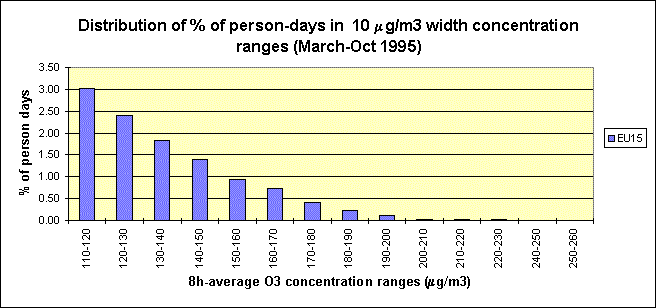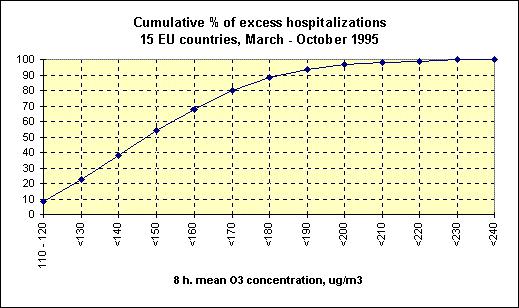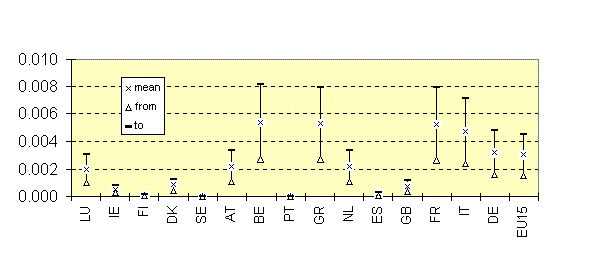6. Health effects of exposure to
ozone
6.1 Health significance of
exposure to ozone
As ozone is a powerful oxidant it can react with a wide range of
cellular components and biological materials, and may affect tissues of the respiratory
tract or lung. The accumulated evidence on health effects is reviewed in WHO (1987) and
WHO (1995). Most of the evidence on effects of ozone in concentrations common in the
troposphere relates to short term (hours) exposures. Impacts in populations residing in
areas where ozone levels are elevated for prolonged periods are more difficult to be
detected and are still uncertain.
The relationship that is relatively best established and quantified
is that of pulmonary function to ozone exposure (Rombout, 1997). Studies indicate that
exposures to ozone concentrations in the range 160 - 360 µg.m-3 for a period
of 1-8 hours reduces various pulmonary function parameters. Concentrations in the lower
part of this range are often observed in Europe, whereas those in the upper part are
detected only occasionally. After cessation of exposure, lung function returns to
pre-exposure level. The ozone concentration and the dose rate (depending on the
ventilation rate) are more important determinants of the effect than duration of exposure.
Impacts on incidence of respiratory symptoms (including cough,
throat irritation, chest tightness) have also been reported at the same range of exposures
as those affecting pulmonary function though the effects are rarely correlated on an
individual basis. Ozone also induces inflammatory response in the lung. Epidemiological
studies indicate that the rates of asthma attacks and medication usage increase on days
with higher ozone concentrations. The rates of visits to hospital emergency rooms and
hospital admissions for asthma and other respiratory conditions are also increased on such
days.
The recently revised WHO Air Quality Guidelines have established a
guideline value for ambient air of 120 µg.m-3 for a maximum period of 8 hours
per day as a level at which acute effects on public health are likely to be small (WHO,
1997). However, as the available data show, a small part of the population may experience
some impacts on their health even at ozone concentrations around the guideline value. The
risk of these outcomes can be estimated on the basis of the tables provided with the
guidelines. For example, 8 hour exposure to ozone at concentration of 120 µg.m-3
is expected to induce 5% (transient) decrement in FEV1 (pulmonary function parameter) in
the active, healthy, most sensitive 10% of young adults and children; at 160 µg.m-3
this decrement is expected to be over 10% of normal level, which might be of health
significance. Furthermore, an increase in 8-hour average ozone concentration by 100 µg.m-3
is expected to induce:
- 25% increase in symptom exacerbation among adults and asthmatics
involved in normal activities;
- 10% increase in hospital admissions for respiratory conditions.
The above increases in risk of health effects assume linear
relationships between the ozone concentrations and health effects in the range of
concentration currently observed in ambient air. It must however be recognised that a
great deal of uncertainty exists in respect to the shape of these relationships. It is
likely that the health benefits of reduction of exposures to high concentrations are
greater than the same absolute reduction of exposures in the lower concentration range.
A limited number of studies have analysed relations of short-term
changes in mortality to ozone concentration. Anderson et al. (1996) reported a 3%
increase in all cause mortality associated with a 50 µg.m-3 increase of 8-hour
mean ozone in London, in the warm season. Similar association, also for a warm season
only, is shown in a study in Barcelona (Sunyer et al., 1996). An analysis of
mortality in the elderly during a hot summer in Belgium indicates that the observed
relationship depends on the range of temperatures and can be seen mainly on hot days
(Sator et al., 1997). Several other studies have not, however, confirmed these
associations, especially after consideration of confounding effects of pollution with
inhalable particles. Due to the lack of consistency between the studies and no agreement
concerning causality of the observed associations, it was decided to omit possible effects
of ozone on daily mortality rates in the analysis which is presented in further sections.
Although chronic exposure to ozone can cause effects, quantitative
information from humans is inadequate to estimate the extent of impacts of long-term
exposure.
6.2 Estimation of health impact
of exposure to ozone in 15 EU countries
All health outcomes which can follow exposure to ozone at the
concentrations encountered in Europe are rather non-specific and, in most cases, are also
caused by a variety of other causes than air pollution. Therefore, a direct determination
of the magnitude of the pollution impact is not possible. However, the proportion of the
cases which can be attributed to the pollution can be estimated on the basis of
information on population exposure to the pollution and using information from
epidemiological studies on exposure - response relationships.
Estimates of population exposure to ozone
For the present assessment, the 1995 data on 8-h average ozone
concentrations collected in the framework of the European Council Directive (92/72/EEC)
have been used. Unfortunately, according to the Directive, only the data from days with
ozone concentration exceeding 110 µg.m-3 are collected, and the information on
the frequency of days in lower concentration ranges was not available for this analysis.
It has been assumed that each 'urban/street' monitoring location (400 sites) is spatially
representative of a circle with a 10 km radius. Overall, some 11.7% of the 15 EU
countries' population (ca. 41 million people) live within such circles. This proportion
varies from 0.3% in France to 35.4% in Germany. Based on the population density in the
circles, the 8-h average concentration data has been used to estimate the frequency
distribution of person-days exceeding 110 µg.m-3 using 10 µg.m-3
ranges of O3 concentration. In the period March - October 1995, in all 15
countries, the 8-h average ozone concentration exceeded 110 and 120 µg.m-3 for
11.2% and 8.2% of person-days respectively. The level of 160 µg.m-3 was
exceeded during 1.6% of person-days. Figure 20 illustrates an estimate of the frequency
distribution of the percentage of person-days in certain concentration ranges in the
summer of 1995 in the EU15 countries.
The EU wide ozone network being used in this assessment is composed
from various national networks. Unfortunately, these national networks were not designed
using homogeneous station siting criteria. Error! Reference source not found. and section
5.2 illustrate that some countries use a large fraction of 'kerb-side' street sites to
monitor urban ozone. Due to local emissions suppressing ozone levels at these sites it is
likely that the real level of population exposure is underestimated, in the south of
Europe in particular. This, in turn, leads to underestimation of effects.

Figure 20: The distribution of person-days with 8-h
average concentration ranges above 110 mg.m-3 in EU15 estimated over
March-October 1995.
Estimation of health impact of ozone in 15 EU countries
The exposure to ozone in concentrations observed in Europe may lead
to a range of health effects. In a sensitive part of population, transient decrements of
lung function and exacerbation of respiratory symptoms such as cough and wheezing can be
expected. As mentioned in section 6.1, at least 10% decrement in lung function is expected
to occur in 10% of the most sensitive subject on days with 8-hour mean concentrations
exceeding 160 µg.m-3. According to the exposure estimates, 1.58% of
person-days belonged to that range in March-October 1995 in the areas covered by ozone
monitoring. Therefore, one can estimate that some 65 thousand cases could have occurred in
the monitored areas, or more than 500,000 if the estimate is generalised to the whole
population of the 15 EU countries. While the 10% transient decrement of FEV1 should not
create problems for most people, the capacity for normal activities may be decreased in
those subjects whose respiratory capacity has been already reduced due to age, disease or
other factors.
In some cases, the symptoms may lead to use of medication or even to
hospitalisation. The association between daily changes in the number of hospital
admissions and concentration of ozone have been observed in a number of studies, including
the APHEA study analysing data from five large European cities (Anderson et al.,
1997). For the present analysis, the estimates of risk from that study have been used to
calculate the proportion of hospital admissions attributable to ozone exposure. According
to the definitions used by the APHEA study, we have considered emergency hospital
admissions for bronchitis, emphysema and chronic airways obstruction. Although these
admissions are not labelled as "emergency" in all countries, they are, in most
cases, caused by symptoms requiring immediate medical assistance.
Based on the estimated exposure distribution and relative risk
estimates from the APHEA study, we calculated that 0.3% (3 in 1000) of the admissions
could be attributed to the ozone exposure exceeding 110 µg.m-3 in all 15 EU
countries. More than 80% of the excess cases could be attributed to ozone concentrations
in the range of 110-170 µg.m-3 (Figure 21). The proportion of admissions
attributed to the ozone exposure was estimated to be highest in Belgium, France and
Greece, where it exceeded 0.5% of the admissions (Figure 22).

Figure 21: Cumulative distribution of the percentage of
excess hospitalisations due to ozone exposure in the EU15 (March-October, 1995)
To estimate the absolute number of admissions attributable to ozone
exposure, it is necessary to assume the average frequency of hospitalisation in the
population. Hospital admission is used here as an index of deterioration in health
requiring medical treatment. The need to use this form of assistance in case of acute
respiratory symptoms depends on the system of medical services and medication use
practices. This may vary between populations and, certainly, between countries. Therefore,
the underlying rates of emergency hospital admissions may vary substantially. However,
such data is not readily available for all countries considered and, for the present
analysis, we used the frequency observed in London (20 cases per day in a 7.3 million
population, i.e. 2.74 admissions per million per day).
In all populations covered by ozone monitoring (i.e. living within
10 km circles around the monitoring locations), the number of additional hospital
admissions attributable to ozone exposure in concentrations exceeding 110 µg.m-3
is estimated to be just over 80 cases in all 15 EU countries, in the period March -
October 1995. Most of the attributable cases would have been registered in Germany where
the greatest number of people has been covered by O3 monitoring. If it is
assumed that the exposure situation around the monitors represents the overall
distribution of exposure in the country, the estimates for the monitored populations can
be extrapolated to all country population, and to all 15 EU countries. Such extrapolation
indicates that almost 700 hospital admissions could have been attributed to the
ozone in concentrations exceeding 110 µg.m-3 in all 15 EU countries in the
period March - October 1995. More than 75% of all those additional cases would have
occurred in three countries: France, Italy and Germany.
Effects of the exceedance of 110 µg/m3 vs. total
effects of exposure to ozone
The available data from ozone concentration monitoring allow to
estimate the effects of the exceedance of 110 µg.m-3. However, epidemiological
studies have registered an increment in the frequency of hospital admissions with ozone
concentrations well below this level. Similar observations were made by the APHEA study
(Ponce de Leon, 1996). Therefore, it can be assumed that the real impact of the pollution
is greater than that estimated above. A conservative estimate, based on typical
distribution of ozone concentrations, assuming that for 20-40% person-days ozone
concentration was in the range 60-110 µg.m-3, suggests that the proportion of
hospital admissions attributable to ozone concentration over 60 µg/m3 can reach 1.5% of
all admissions (i.e. amount to 400 admissions in the populations covered by the
monitoring, or to more than 3000 admissions in all population of 15 EU countries).

Figure 22: Proportion of hospital admissions
attributable to 8-hour average ozone concentrations above 110 mg.m-3 in each of
the EU15 Member States (March-October, 1995)
Uncertainties in the estimates
There are several uncertainties in the above estimates. Probably the
most reliable estimates are the attributable proportions when applied to the populations
living in areas surrounding the monitors providing ozone concentration data. The APHEA
study, the source of relative risk estimates, has analysed data from five different
cities, and the combined estimate should reflect average exposure - response association
in other populations than those considered in the present analysis. The tables and graphs
presented indicate the magnitude of possible error related to the uncertainty of the
relative risk estimate obtained by the APHEA study. Considering this, the proportion of
hospital admission attributable to ozone in concentration over 110 µg/m3 should be in the
range from 0.15% to 0.45%. However, the uncertainty concerning the exposure pattern within
the (arbitrarily selected) 10 km circle around the monitoring station is not reflected in
the present calculations. If the number of person-days with ozone concentrations over 110
µg/m3 (at each concentration category) is twice as big as the number estimated above, the
attributable proportion would double as well.
A further important limitation of this analysis is the fact that a
large part of the air quality data has been obtained from 'kerb-side' street sites. This
data may provide very inaccurate estimates for the quality of air that people breathe and
severely underestimate real level of exposure to ozone. Secondly, the extrapolation of the
exposure distribution from the populations living close to the monitors to the whole
country is an uncertain step. It is unlikely that the scarce monitoring data represents
the total population exposure. There are also other errors of estimation. Therefore
interpretation of data for individual countries must be done with caution, especially for
these countries with small proportions of population covered by air quality monitoring.
Transient decrements in lung function and increases in hospital
admission rates are the health outcomes for which the associations with exposure to ozone
in concentrations observed in Europe are relatively the best established and quantified.
Therefore the estimation of the magnitude of the impacts was possible, and performed, in
this analysis. Other health effects, such as respiratory symptoms or short term changes in
mortality rates could also result from ozone exposure in the period analysed but the
information necessary for the estimation of effect is not sufficient for the
quantification of the impacts.




Document Actions
Share with others